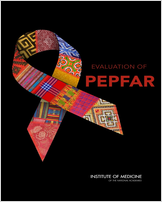NCBI Bookshelf. A service of the National Library of Medicine, National Institutes of Health.
The U.S. government supports programs to combat global HIV/AIDS through an initiative that is known as the President's Emergency Plan for AIDS Relief (PEPFAR). This initiative was originally authorized in the U.S. Leadership Against HIV/AIDS, Tuberculosis, and Malaria Act of 2003 and focused on an emergency response to the HIV/AIDS pandemic to deliver lifesaving care and treatment in low- and middle-income countries (LMICs) with the highest burdens of disease. It was subsequently reauthorized in the Tom Lantos and Henry J. Hyde U.S. Global Leadership Against HIV/AIDS, Tuberculosis, and Malaria Reauthorization Act of 2008 (the Lantos-Hyde Act).
Evaluation of PEPFAR makes recommendations for improving the U.S. government's bilateral programs as part of the U.S. response to global HIV/AIDS. The overall aim of this evaluation is a forward-looking approach to track and anticipate the evolution of the U.S. response to global HIV to be positioned to inform the ability of the U.S. government to address key issues under consideration at the time of the report release.
Contents
- THE NATIONAL ACADEMIES
- COMMITTEE ON THE OUTCOME AND IMPACT EVALUATION OF GLOBAL HIV/AIDS PROGRAMS IMPLEMENTED UNDER THE LANTOS-HYDE ACT OF 2008
- Reviewers
- Acknowledgments
- Preface
- Acronyms and Abbreviations
- Summary
- I. Introduction
- II. PEPFAR Organization and Investment
- III. PEPFAR Programmatic Activity
- 5. Prevention
- EVOLUTION OF HIV PREVENTION SCIENCE
- OVERVIEW OF PEPFAR-SUPPORTED PREVENTION PROGRAMS
- PREVENTION OF SEXUAL TRANSMISSION
- PREVENTION OF MOTHER-TO-CHILD TRANSMISSION
- INJECTION DRUG USE
- BLOOD AND MEDICAL INJECTION SAFETY
- HIV COUNSELING AND TESTING
- ANALYSIS OF PREVENTION IMPACT
- INTERVENTIONS ON THE HORIZON FOR PREVENTION STRATEGIES
- SUMMATION
- REFERENCES
- 6. Care and Treatment
- 7. Children and Adolescents
- 8. Gender
- 9. Strengthening Health Systems for an Effective HIV/AIDS Response
- 5. Prevention
- IV. Future of U.S. Government Involvement in the Global Response to
HIV/AIDS
- 10. Progress Toward Transitioning to a Sustainable Response in Partner Countries
- 11. PEPFAR's Knowledge Management
- INTRODUCTION
- PROGRAM TARGETS AND PRIORITIES
- PROGRAM MONITORING DATA
- PEPFAR SUPPORT FOR EPIDEMIOLOGICAL DATA
- PEPFAR SUPPORT FOR DATA USE BY PARTNER COUNTRY STAKEHOLDERS
- PEPFAR-SUPPORTED EVALUATION AND RESEARCH ACTIVITIES
- KNOWLEDGE TRANSFER AND LEARNING WITHIN PEPFAR
- PEPFAR'S KNOWLEDGE DISSEMINATION EXTERNAL TO PEPFAR
- SUMMATION
- RECOMMENDATIONS
- REFERENCES
- Appendixes
This study was supported by Contract/Grant No. SAQMMA09M0693 between the National Academy of Sciences and the U.S. Department of State. Any opinions, findings, conclusions, or recommendations expressed in this publication are those of the author(s) and do not necessarily reflect the views of the organizations or agencies that provided support for the project.
Suggested citation:
IOM (Institute of Medicine). 2013. Evaluation of PEPFAR. Washington, DC: The National Academies Press.
NOTICE: The project that is the subject of this report was approved by the Governing Board of the National Research Council, whose members are drawn from the councils of the National Academy of Sciences, the National Academy of Engineering, and the Institute of Medicine. The members of the committee responsible for the report were chosen for their special competences and with regard for appropriate balance.
